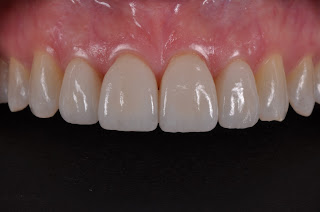Let's start with point flashes. As their name implies, they shed a point of light, from an angle to the subject. The great thing about point flashes is that they give shadows. Think of walking down the street near sunset. The shadows are nice and long.
 |
| Shadows are what distinguish decent from awesome dental images. |
 |
| Negative spaces between teeth and on surfaces really allow one to see surface texture |
Traditionally, point flashes were single in number and cast shadows in only one direction. However, a couple of decades ago, someone got the great idea to place the flash on both sides of the lens and the quality of images jumped through the roof. Nowadays, wireless flash systems like the one from Nikon allow photographers to put as many flashes as they like around the lens. I often see dentists with upwards of 4 point flashes around a lens and for pure shooting purposes, they have turned a point flash into a ring flash. For the record, I've gotten some gorgeous images with just 2 flashes and don't see the need for anything more.
The Nikon R1 (or R1C1) is a simple example of dual point flash use. You'd almost have to be blind to confuse it with a ring flash. This is my favorite flash for dentistry because it throws nice long shadows due to its distance from the lens.
 |
| The Nikon R1 is an amazing flash which gives great surface texture |
The Canon MT24-EX is also pretty easy to distinguish as a dual point flash , however, it's high cost and super bright lights make it a less than ideal flash for most dentists.
 |
| The Canon MT-24EX is an amazing flash but very expensive and needs an experienced user to control |
So, what about the most common flash, the Canon MT14-EX? Almost every doctor I've met who uses it calls it a ring flash, but it isn't. It's a dual point flash because each side can be independently turned on or off and this is REALLY important (as I will get to soon). It's a great flash...if you know how to use it properly, and very few do.
 |
| Most owners of the Canon MT-14EX don't know if it's a ring flash or double point flash |
The Metz 1510 is a pure ring flash. I am not at all a fan of it for many reasons, and you can email me if you want to know more.
 |
| Don't be lured by the wireless nature of the Metz flash. For the money, there are WAY better options |
Here's the key fact. If you want to get great images of your patients to hang on the wall, get great depth of field or communicate with labs or other dentists, you had better know how to use your flash properly.
To learn more about our clinical photography DVD series which will get you shooting the best dental images imaginable, simply click HERE.
Best Wishes,
Glenn

I agree with the comment about the Metz flash. I bought it, and had a terrible time with color accuracy. In the end, I went back and bought (again) the flash I had that could no longer be repaired (after 10 years!): Canon MT14EX. I would not waste time trying the Metz. Nobody talks about the color issue (except in this blog), and it is a serious issue if you are serious about photography
ReplyDeleteHad huge color accuracy issues with the Metz, and finally went back to my old Canon ringlfash MT14 Ex. No problems now. Do not recommend the Metz, I agree with Dr. K.
ReplyDeleteI exactly was looking for such an information. Finally I got it. Thank you.
ReplyDeleteI accept as true with the comment regarding the Metz flash. I bought it, and had a terrible time with color accuracy
ReplyDelete